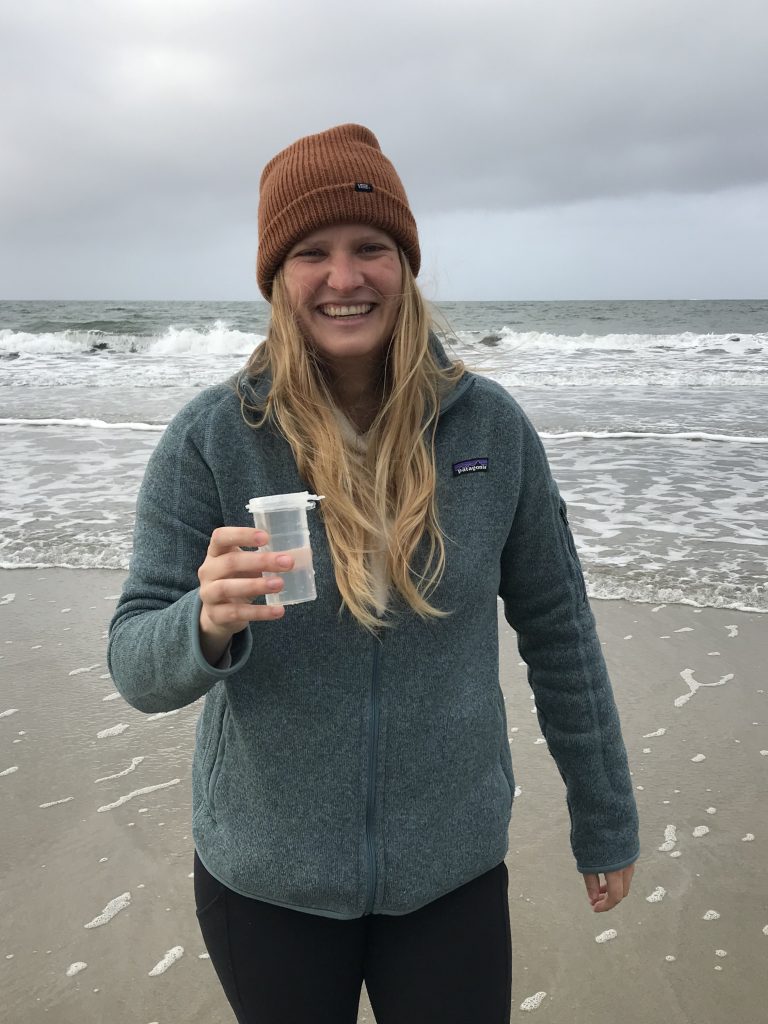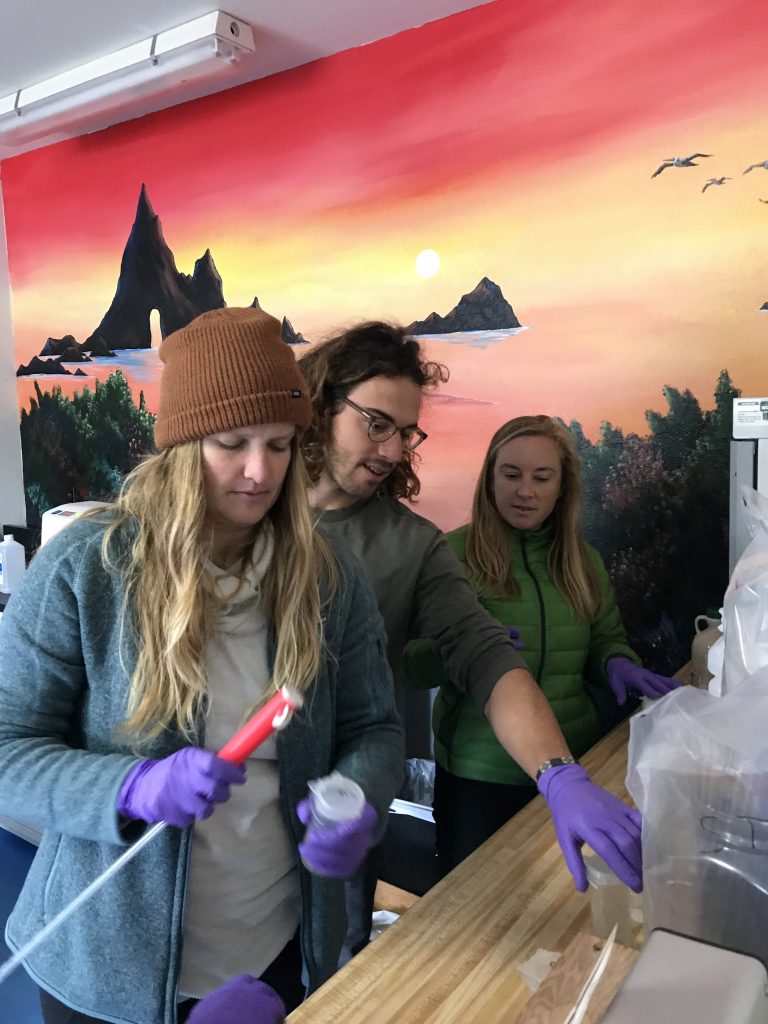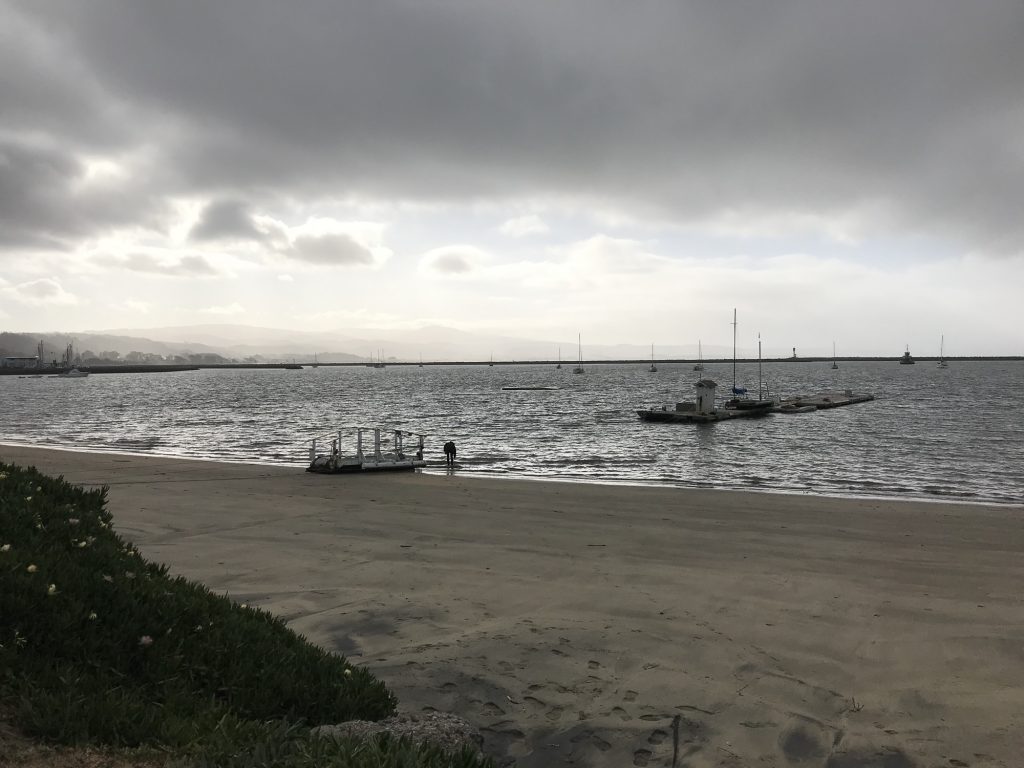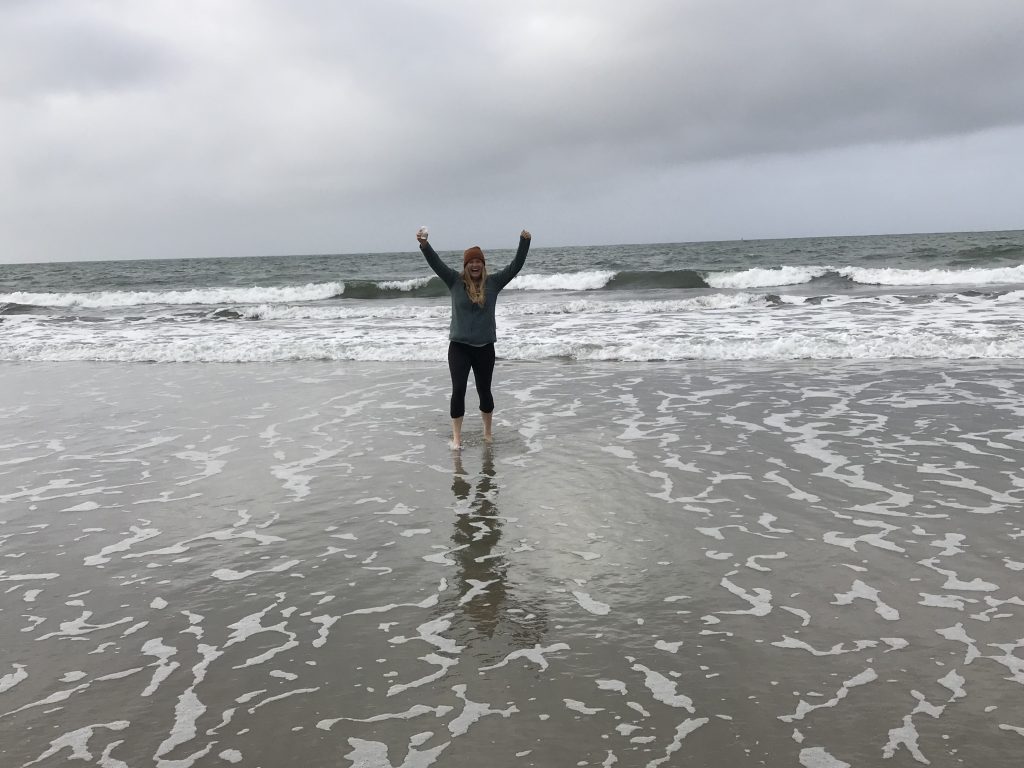
by Angie Whittemore

“Rub in between your fingers,” I said to my three-year-old daughter, turning on the faucet. “You don’t see the bugs but they are there.” Water poured onto her soapy hands and carried bubbles down the drain. We watched the water flow until it ran clear. It was early March, and I was teaching my daughter to wash her hands correctly, as many parents around the world were doing as word of the novel coronavirus was beginning to spread.
A few days later I was testing ocean water that appeared clear enough to have run from the faucet, but is actually highly polluted. We are at Linda Mar Beach, a break I often surf. One volunteer, Anna, holds up a vial of water that is completely translucent. I can see right through it to the blue ocean and the cloudy sky. It is as clear as natural spring water I’ve seen flowing out of the earth. We collect the water where San Pedro Creek meets the Pacific, on the south end of the cove. This crescent-shaped beach sits below a forested bluff of Eucalyptus and pine trees. The rocky cliffs, prevalent on this stretch of Central California coast, offer the towery backdrop to these sandy shores.

I’m with Ryan Searcy, an environmental engineer who is a Surfrider Blue Water Task Force member and regularly checks the water quality at local beaches. Ryan is an expert on water quality. Three of my friends are along as well. All are local surfers and concerned citizens. We’ve been concerned with the water quality at Linda Mar since 2017, when the beach made the Heal the Bay’s list of ten worst beaches in California. The beach has been making the annual list ever since. We join Ryan to understand what Surfrider Foundation San Mateo is doing about this issue.
Surfrider San Mateo conducts weekly water testing at five local beaches so the organization and the public are aware of water quality. Currently we test and post results for Linda Mar at San Pedro Creek, San Vicente Creek at Fitzgerald Marine Reserve, Surfer’s Beach, and two spots in Half Moon Bay Harbor. In addition to the testing by Surfrider, San Mateo County also tests water quality at these beaches and several other beaches and creeks, including beaches on the Bay-side. (Their weekly report is posted online.) Surfrider provides an additional reference point because water quality can change day to day, depending on the weather and other variables.

Surfrider BWTF tests for Enterococcus, an indicator bacteria for the presence of fecal matter (that’s right, poop). These bacteria come from warm-blooded animals (people, horses, birds, dogs, sea lions) and travel into the ocean waters where we surf, swim and play. Skin rashes, eye and ear infections, and gastro-intestinal issues can all result from swimming in water with fecal contamination. My friends have been ill after surfing Linda Mar; I have also become sick after surfing there. While rare, diseases such as E. Coli, giardia and hepatitis can be contracted through exposure to feces. Regarding COVID-19, the research community currently does not know whether the virus can be contracted through saltwater, though they report it is possible.
San Pedro Creek is our first sample. As Anna holds up the vial of water, Ryan explains this spot regularly contains unhealthy levels of Enterococcus. And sure enough, we learn later this clear water exceeds safety thresholds for healthy swimming water established by the state. In fact, another BWTF volunteer we met at a Surfrider meeting, Edo, recounted testing his toilet water recently and found that water in his un-scrubbed bowl was less contaminated than that at San Pedro Creek.
While we work, dozens of surfers sit right out from us. They are upright on their boards in the water, their backs to the shore. The mouth of the Creek and the break to the south are popular surf spots, though this is often the most contaminated part of the beach. The Creek empties in both dry and wet weather, so even when it hasn’t been raining, the potential for fecal bacteria remains high. During and after a rain, contamination levels peak. I’ve often seen children playing happily in the shallow creek as their parents look on contentedly.
After Linda Mar, we drive to Fitzgerald Marine Reserve to test the San Vicente Creek. This site has also regularly exceeded safe bacteria levels over the past year. We then test Surfer’s Beach and finally two spots in Half Moon Bay Harbor. When we finish, we bring the samples back to the Surfrider Lab and prepare them for testing. This involves mixing the samples with filtered water, adding a nutrient that will reveal the indicator bacteria, and pouring the water into sample trays. The results will be visible in 24 hours.
Contaminants are measured in most-probable-number of colony-forming units (mpn) per 100 milliliters. High contamination specified by the California State Water Resources Board is anything above 104. Low contamination is anything below 35.
The next day, Ryan emails the numbers. Sure enough, Linda Mar had high levels of contamination, registering an mpn level of 108. San Vicente Creek and Surfer’s Beach both had low contamination levels, with measurements of less than 10. The water samples from both sites in the Harbor exceeded 215. I make a mental note that I will definitely check local water quality conditions before I allow my children to play in the Harbor again.
It troubles me to know how contaminated the water is where I surf and allow my children to play. While I understand the ocean’s vulnerability to the drainage of filth from cities and streets, I can’t help being alarmed at the levels of contamination I witnessed. I’m surprised more people aren’t talking about this. Linda Mar ranked third most contaminated beach in the state last year. Thousands of people surf and swim and play at Linda Mar. Warning signs are posted when the water exceeds healthy thresholds, but most of us shrug our shoulders.
Finding and mitigating contamination sources and/or treating water before it flows into the ocean is possible. It would require government offices working together, increased funding, and perhaps a public outcry. Surfrider San Mateo plans to address the issue this coming year and will formulate a plan to help solve this problem.
Angie is one of our newest Blue Water Task Force members on our quickly growing team! To join this effort or to learn more about the Blue Water Task Force’s work testing water quality at our local beaches, contact our Blue Water Task Force Coordinator, Chris DeVry, at bwtf@smc.surfrider.org.

